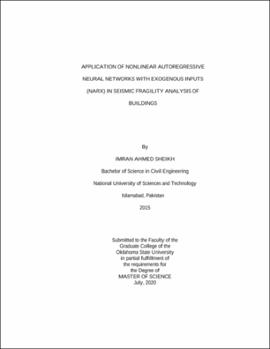| dc.contributor.advisor | Soliman, Mohamed | |
| dc.contributor.author | Sheikh, Imran Ahmed | |
| dc.date.accessioned | 2021-02-22T22:41:23Z | |
| dc.date.available | 2021-02-22T22:41:23Z | |
| dc.date.issued | 2020-07 | |
| dc.identifier.uri | https://hdl.handle.net/11244/328670 | |
| dc.description.abstract | Rapidly growing societal needs in urban areas are increasing the demand for tall buildings with complex structural systems. Many of these urban areas are located in zones characterized by high seismic activity. Quantifying the seismic resilience of these buildings require comprehensive fragility and risk assessment that integrates iterative nonlinear dynamic analyses to properly account for uncertainties. Under these circumstances, traditional finite element (FE) analysis may become impractical due to the high computational cost associated with fragility analysis. Soft-computing methods can be applied in the domain of nonlinear dynamic analysis to reduce the computational cost of seismic fragility analysis. Taking advantage of the computational efficiency of artificial neural networks, this study presents a framework that employs nonlinear autoregressive neural networks with exogenous input (NARX) in fragility analysis of multi-story buildings. The presented framework uses structural health monitoring data to calibrate a nonlinear FE structural model. The FE model is employed to generate the training dataset for NARX neural networks with acceleration and displacement time histories as input and output for the neural network, respectively. The trained NARX networks are then used to perform incremental dynamic analysis (IDA) for a suite of ground motions. Fragility analysis is next conducted based on the results of IDA obtained from the trained NARX network. The aforementioned framework is illustrated on a twelve-story reinforced concrete building located at Oklahoma State University, Stillwater campus. Results show that NARX networks have the potential to significantly improve the computational efficiency of fragility and reliability analysis of structures in seismically active regions. | |
| dc.format | application/pdf | |
| dc.language | en_US | |
| dc.rights | Copyright is held by the author who has granted the Oklahoma State University Library the non-exclusive right to share this material in its institutional repository. Contact Digital Library Services at lib-dls@okstate.edu or 405-744-9161 for the permission policy on the use, reproduction or distribution of this material. | |
| dc.title | Application of nonlinear autoregressive neural networks with exogenous inputs (NARX) in seismic fragility analysis of buildings | |
| dc.contributor.committeeMember | Russell, Bruce W. | |
| dc.contributor.committeeMember | Emerson, Robert N. | |
| osu.filename | Sheikh_okstate_0664M_16869.pdf | |
| osu.accesstype | Open Access | |
| dc.type.genre | Thesis | |
| dc.type.material | Text | |
| dc.subject.keywords | incremental dynamic analysis | |
| dc.subject.keywords | narx | |
| dc.subject.keywords | neural networks | |
| dc.subject.keywords | nonlinear dynamic analysis | |
| dc.subject.keywords | seismic fragility | |
| dc.subject.keywords | structural health monitoring | |
| thesis.degree.discipline | Civil Engineering | |
| thesis.degree.grantor | Oklahoma State University | |
